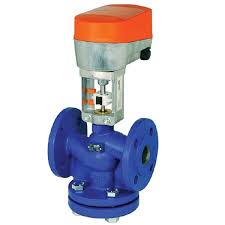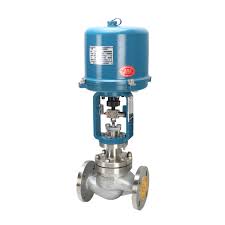Electric Globe Control Valve DN200

The Application of Electric Globe Control Valve
The Electric Globe Control Valve is a versatile and reliable solution for industrial applications. Manufactured by leading Industrial globe valve suppliers like Cameron, these valves offer precise flow control and improved energy efficiency. The Electric control valve maintenance is straightforward, ensuring smooth and continuous operation. Energy-efficient control valves play a crucial role in optimizing resource utilization and reducing operational costs. The Electric Globe Control Valve’s ability to integrate seamlessly with automated systems makes it an excellent choice for a wide range of industries, from petrochemical refineries to power generation facilities. Its robust design and advanced features make it a trusted solution for managing critical processes and enhancing overall system performance.
What Are The Types Of Electric Globe Control Valve?
- Standard Electric Globe Valves: These are the most common type of electric globe valves, featuring a simple design and reliable performance for general industrial applications.
- High-Performance Electric Globe Valves: These valves are engineered for demanding applications that require high pressure, high flow, and tight shutoff capabilities. They often incorporate advanced trim designs and specialized materials.
- Characterized Electric Globe Valves: These valves have a modified plug design that provides a predefined flow characteristic, allowing for precise flow control and easier system integration.
- Modulating Electric Globe Valves: These valves are capable of positioning themselves at any intermediate point between fully open and fully closed, enabling smooth and precise flow modulation.
- Cryogenic Electric Globe Valves: Designed for low-temperature applications, these valves feature specialized materials and seals to withstand the extreme conditions encountered in cryogenic processes.
- Diaphragm Electric Globe Valves: Incorporating a diaphragm instead of a piston, these valves offer improved leak-tightness and are often used in applications with dirty or corrosive media.
What Is Electric Globe Control Valve?
An Electric Globe Control Valve is a type of industrial valve that utilizes electric actuators to precisely regulate the flow of fluids, gases, or other media. Unlike manual or pneumatic globe valves, the electric operation of these valves allows for automated, remote, and highly accurate control of the flow. The globe valve design provides a predictable and stable flow characteristic, making it well-suited for applications that require precise flow management, such as in process control systems, chemical plants, power generation facilities, and various other industrial settings. The integration of electric actuation enables these valves to be seamlessly incorporated into digital control systems, allowing for enhanced process optimization, improved energy efficiency, and reduced operational costs.
How to Select the Right Electric Globe Control Valve?
Selecting the right Electric Globe Control Valve for a specific application involves considering several key factors. The flow rate, pressure, temperature, and fluid properties of the process are crucial in determining the appropriate valve size, materials, and design features. Additionally, factors such as the required control accuracy, response time, and rangeability of the valve must be evaluated to ensure optimal performance and compatibility with the overall system. Consulting with experienced industrial globe valve suppliers and reviewing the technical specifications of various valve models can help ensure the selection of the most suitable Electric Globe Control Valve for the application, ultimately leading to reliable and efficient process control.
Features of Electric Globe Control Valve
Precise Flow Control: The precise control of the valve plug/seat interface allows for accurate regulation of fluid/gas flow, enabling fine-tuned process control.
Automated Operation: The integration of electric actuators enables remote operation, automated control, and seamless integration with digital control systems.
Improved Energy Efficiency: The electric design of these valves can contribute to reduced energy consumption compared to traditional pneumatic or manual globe valves.
Reliable Performance: Robust construction and specialized materials ensure durable and reliable operation, even in demanding industrial environments.
Easy Maintenance: The electric actuation simplifies the maintenance process, often requiring less downtime and fewer specialized skills compared to other valve types.
Versatile Applications: Electric Globe Control Valves are widely used in a variety of industries, including petrochemical, power generation, water treatment, and more.
Enhanced Process Control: The precise flow control and integration capabilities of these valves help optimize process efficiency and improve overall system performance.
Advantages and Disadvantages of Electric Globe Control Valve
Advantages of Electric Globe Control Valve:
- Precise Flow Control: Electric globe control valves offer superior flow control accuracy and repeatability compared to manual or pneumatic valves.
- Energy Efficiency: The electric actuation system typically consumes less energy than pneumatic or hydraulic counterparts, contributing to improved energy efficiency.
- Automated Operation: Electric valves can be easily integrated into automated control systems, enabling remote operation and enhanced process optimization.
- Reduced Maintenance: Electric actuators generally require less maintenance than other actuation methods, reducing operational costs and downtime.
- Versatility: Electric globe control valves are suitable for a wide range of industrial applications, from petrochemical to water treatment.
Disadvantages of Electric Globe Control Valve:
- Higher Initial Cost: Electric globe control valves often have a higher upfront capital cost compared to manual or pneumatic valves.
- Power Dependency: The operation of electric valves requires a reliable power supply, which can be a concern in some industrial settings.
- Limited Size Range: Electric globe control valves may have a more limited size range compared to other valve types, which can be a limitation for certain applications.
- Complexity: The integration of electric actuation and control systems adds complexity to the overall valve design, which may require specialized expertise for installation and maintenance.
- Environmental Factors: The performance of electric valves can be affected by ambient temperature, humidity, and other environmental conditions, which must be considered in the selection and installation process.

The Specifications of Electric Globe Control Valve
| Specification | Details |
|---|---|
| Type | Electric Globe Control Valve |
| Ball Material | Stainless Steel |
| Attachment Type | Threaded |
| Thread Standard | NPT |
| Thread Size | 1 inch |
| Body Material | Cast Iron |
| Safe for Use With | Water, Oil, Gas |
| Handle Type | Electric Actuator |
| Handle Material | Aluminum |
| Maximum Working Pressure (psi) | 150 |
| Maximum Working Pressure (bar) | 10.3 |
| Operating Pressure (psi) | 100 |
| Operating Pressure (bar) | 6.9 |
The Installation Steps for Electric Globe Control Valve
- Site Preparation: Ensure the installation location provides adequate space for the valve and its associated components, such as the electric actuator and control wiring.
- Valve Orientation: Determine the proper orientation of the valve based on the flow direction, accessibility requirements, and any specific installation guidelines provided by the manufacturer.
- Pipe Alignment: Align the valve with the piping system, ensuring the inlet and outlet connections are properly aligned to prevent any stress on the valve body.
- Threaded Connection: For threaded connections, apply a suitable thread sealant or tape to the valve threads and carefully thread the valve into the piping system, ensuring a tight and leak-free seal.
- Electrical Connections: Connect the electric actuator to the power supply and any necessary control systems, following the manufacturer’s wiring diagrams and instructions.
- Actuator Configuration: Configure the electric actuator settings, such as the open and close positions, torque limits, and any required programming or calibration.
- Valve Inspection: Visually inspect the valve and its components to ensure there are no signs of damage or interference with the surrounding structures or piping.
- Leak Testing: Perform a thorough leak test on the installed valve and its connections to verify the integrity of the installation.
- Commissioning: Conduct a final functional test of the electric globe control valve, ensuring it operates smoothly through the full range of motion and responds correctly to the control system signals.
- Documentation: Record the installation details, including the valve model, serial number, and any specific configuration settings, and maintain this information for future reference and maintenance purposes.
The Operation Theory of Electric Globe Control Valve
Operation Theory of Electric Globe Control Valves:
- Valve Design: Electric globe control valves utilize a globe valve design, which features a movable plug that precisely controls the flow by creating a variable flow path within the valve body.
- Electric Actuation: The valve is operated by an electric actuator, which converts electrical signals into mechanical motion to open, close, and modulate the valve position.
- Position Feedback: The actuator incorporates sensors that continuously monitor the valve’s position, providing feedback to the control system for precise flow regulation.
- Control Algorithms: Advanced control algorithms, often integrated into a PLC or DCS, process the position feedback and adjust the actuator accordingly to maintain the desired flow rate or pressure.
Automated Valve Systems:
- Integration with Control Systems: Electric globe control valves are designed to seamlessly integrate with automated control systems, such as Programmable Logic Controllers (PLCs) and Distributed Control Systems (DCS).
- Remote Operation: The electric actuation enables remote operation of the valves, allowing for centralized control and monitoring from a primary control station.
- Process Optimization: Automated valve systems can be programmed to optimize process parameters, such as flow, pressure, and temperature, to improve efficiency, reduce energy consumption, and enhance product quality.
- Increased Reliability: Automated valve systems, with their ability to continuously monitor and adjust valve positions, can provide more reliable and consistent process control compared to manual or pneumatic systems.
Electric Valve Actuator Technology:
- Actuator Types: Electric actuators for globe control valves can be powered by various technologies, such as AC motors, DC motors, or stepper motors, each with its own advantages in terms of speed, torque, and precision.
- Intelligent Actuation: Advanced electric actuators incorporate microprocessor-based controls, enabling features like position feedback, torque monitoring, and diagnostic capabilities for enhanced performance and maintenance.
- Variable Speed Control: Some electric actuators offer variable speed control, allowing for fine-tuned adjustments to the valve position and improved flow regulation.
- Reliability and Durability: Electric actuators are designed to provide reliable and durable operation, with features like weatherproof enclosures and robust construction to withstand challenging industrial environments.
